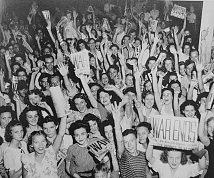
4 minute read
Betty’s Column
from Mt. Morris Times
by Shaw Media
LOCAL HISTORY T he Making of the Bomb in Oak Ridge - Part 7
On Aug. 21, 2020 I wrote an article about the involvementofmyauntanduncleinthemaking of the atomic bomb at Oak Ridge, Tennessee. I receivedseveralcommentsfromothershowthey toohadfamilymemberstakingpartinthatManhattanProject.
A number of weekslatermy cousinsentme a picture ofmy aunt in thenursing home beside her bed that had a beautifulquilt on it. On the quilt was a book titled, “The Girls of Atomic City.”
Thebookansweredmanyquestionsformeand you may be interested in what I found out as I readthisbookpublishedin2013byDeniseKiernan. Thestorylinefollows16women and12men whoplayeda partintheirlives.Theauthorcalled themthe“principalcastofcharacters.”
The ending of the book was just as interesting as the first and life went on in Oak Ridge.
Dot who had handled all the dials, knobs, and had watched the gauges, found herself finally in Hawaii. She had thrown a lei over the ship where her brother had gone down to his death. She had started work in Oak Ridge as a teenager but had aged immensely.
Vi, of the Oak Ridge Journal, spoke of how they had aged so fast in the small amount of time that they were all there. However, many simply wanted to remain in the community they had started and looked for new ways to keep their town going in view of this Atomic Age.
Vi’s husband, Dr. Stafford Warren, had been at the helm of the Manhattan Project’s medical team and he eventually headed to Japan to study the effects of radiation. Many who had survived the initial blast were dying four to six weeks later from bone marrow problems.
Information from the bombings was closely guarded by the War Department. Japan itself kept the information controlled and after the Hiroshima bombing stated “two B-29s had caused a little damage to the city.”
General MacArthur attempted to keep journalists out of Japan. Reports of people dying many weeks later from effects of the bombings were called propaganda by US Military.
True information was very slow in getting out to the public of both United States and Japan. Secrecy still seemed to be the order of the day.
Robert Oppenheimer, the leader of the whole project and head of the lab at Oak Ridge went to pay President Truman a visit. It was October of 1945. The United States was the only one who had the bomb at that point and the president wanted to keep it all a secret.
Oppenheimer doubted that such information could possibly be kept from the world.
Oppenheimer also felt terribly guilty of what he had been a part of in the dropping of the bomb and he expressed his feelings to President Truman. It must have been a terrible thing to have on your conscience.
Eventually President Truman signed the Atomic Energy Act.
With the close of 1946, the population of Oak Ridge was 42,465. Quite a drop from the 75,000 it had been 1945.
As Oak Ridge began to shut down areas, other parts began to change and develop. One part was turned into the Oak Ridge National Lab. This lab would start to research radioisotopes which would lead to cancer research for hospitals in our nation. They worked hand in hand with hospitals.
Recently my grandson, Andrew Obendorf was visiting in our home. We started talking about Oak Ridge and the making of the bomb.
Andrew is an architect for Skidmore Owings & Merrill. He suddenly said, “SOM did all the architectural layout for the Manhattan Project and he has the drawings.”
He was sent a couple of years ago to University of Tennessee at Knoxville to teach some classes on architecture. While there he was given a tour of Oak Ridge and the Oak Ridge National Lab. He said it is a wonderful lab in a beautiful area.
In the book, while there had been no post war plans for Oak Ridge, SOM was called upon once more to come through with some kind of planning. Some of the houses needed to be torn down while other homes were being sold to those who had been renting them.
The barriers of the military were now gone and the town was wide open. A new Oak Ridge was underway.
Kattie, along with her husband, brought their children to Oak Ridge to live in one of the houses. They now had new jobs and they looked forward to raising their family in this new community.
Dot took a job at the new museum when it opened in 1949. When asked how could she have worked on something that destroyed so many people, she replied, “Well, they killed my brother!”
Toni, soon married, continued to live at Oak Ridge as long as they had jobs there. Helen began working in the library and her job was to send out information to other libraries and labs across our country.
Colleen, who remembered seeing women walking in the mud carrying their shoes, ended up lecturing to schools about her job at Oak Ridge. She was part of helping secure an International Friendship Bell “designed in Oak Ridge and cast in Japan” that would ring at various times.
All these women who held secret jobs during the Manhattan Project now focused on creating peace in the world.
COMMENTARY Betty Obendorf Polo Historical Society
Photos supplied by Betty Obendorf
On Aug. 14, 1945 Oakridgers and people everywhere celebrated the end of World War II.
This New York Times bestseller tells the true story of the top-secret World War II town of Oak Ridge, Tennessee, and the young women brought there unknowingly to help build the atomic bomb.




